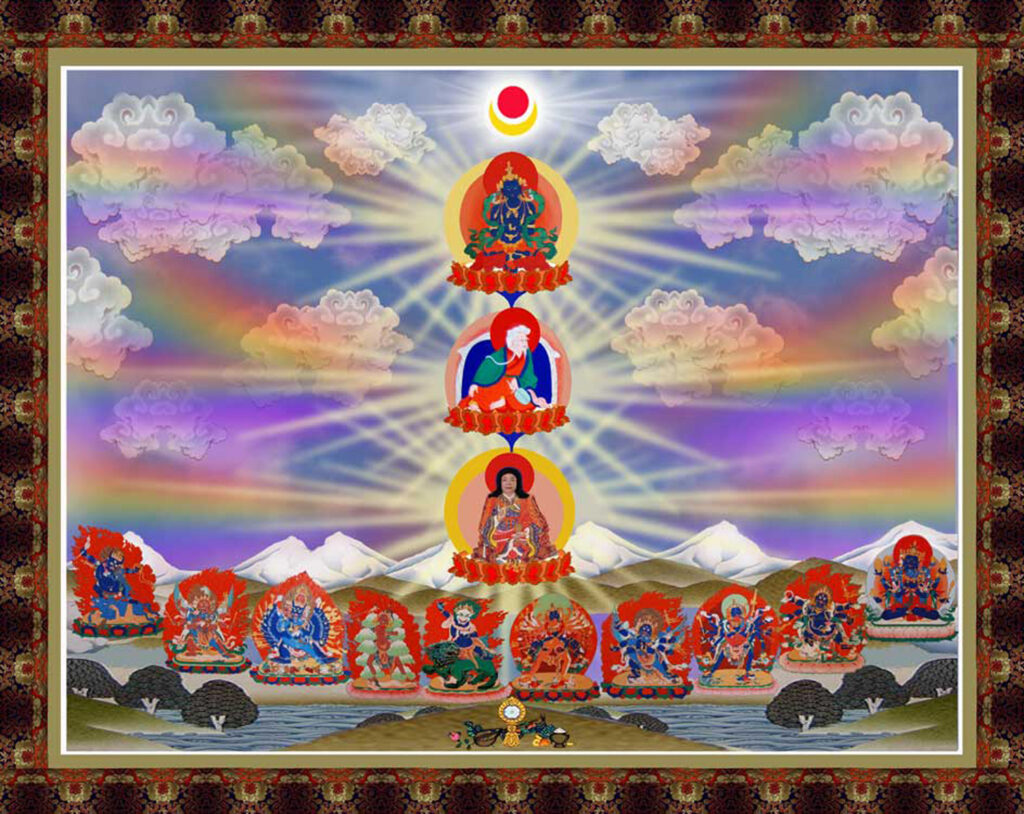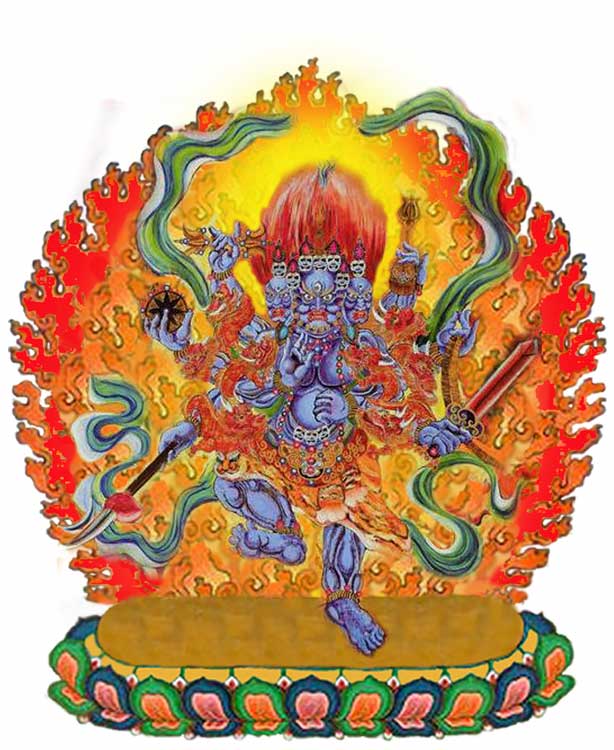
This photo is of the Dorje Chang Lineage Refuge Tree with its ten Dharma Protectors. Our October 19, 2024 class on Lesson 19 of Learning from Buddha College & Seminary course DCB23 discussed several questions on Dharma Protectors including the following on the two kinds of ways Dharma Protectors can help you and how we should treat Dharma Protectors. There are also links to photos of our major Dharma Protectors and related articles.
What are the two kinds of ways that Dharma Protectors can help you?
“Dharma protectors are classified into these few categories [for undertakings and for wisdom]. Dharma protectors for undertakings are Dharma-protecting holy and non-holy beings. They have afflictive habitual tendencies carried over from past lives or stemming from their current life. They have not yet ended the cycle of birth and death. However, they are willing to help us practitioners who cultivate ourselves. When you have cultivated a high moral character, they can come to help you. There are two kinds of ways. One kind is when the Dharma protectors naturally come to your mandala and submit to obeying you. The other kind is when the Dharma protectors are invited to enter your mandala, and a place is established there for them. The Dharma protectors are specifically invited. This requires having the method of practicing a Dharma relating to Dharma protectors to invite them to come. Then they will help you in your good undertakings.”
Why Might your Dharma Protectors leave you?
“However, they conduct themselves in accord with the teachings of the World-Honored Shakyamuni Buddha. They pay particular attention to bodhicitta in the ultimate sense, the Mahayana aspiration, and will look to see whether you act to benefit living beings. Once they help you, they will look to see whether you truly do things for the sake of living beings. If you do not do things for the sake of living beings, they will be unwilling to help you. Additionally, when they see that your cultivation is not good, they will leave you.”
What is the nature of Dharma Protectors for undertakings?
“Dharma protectors for undertakings are Dharma-protecting holy and non-holy beings. They have afflictive habitual tendencies carried over from past lives or stemming from their current life. They have not yet ended the cycle of birth and death. However, they are willing to help us practitioners who cultivate ourselves. When you have cultivated a high moral character, they can come to help you. There are two kinds of ways. One kind is when the Dharma protectors naturally come to your mandala and submit to obeying you. The other kind is when the Dharma protectors are invited to enter your mandala, and a place is established there for them. The Dharma protectors are specifically invited. This requires having the method of practicing a Dharma relating to Dharma protectors to invite them to come. Then they will help you in your good undertakings.”
“However, they conduct themselves in accord with the teachings of the World-Honored Shakyamuni Buddha. They pay particular attention to bodhicitta in the ultimate sense, the Mahayana aspiration, and will look to see whether you act to benefit living beings. Once they help you, they will look to see whether you truly do things for the sake of living beings. If you do not do things for the sake of living beings, they will be unwilling to help you. Additionally, when they see that your cultivation is not good, they will leave you.”
“However, since they are Dharma protectors for undertakings, they belong to the categories of ghosts or deities who have not yet ended the cycle of birth and death. They still have selfish and impure thoughts and have not severed afflictive habitual tendencies. They come to protect you because they covet your merit. Thus, when someone offends their master, they will sometimes become indignant and take action. Such are the shortcomings of Dharma protectors for undertakings.”
What is the nature of wisdom Dharma Protectors?

“However, Dharma protectors for wisdom are not like that. Dharma protectors for wisdom have the state of realization of a Mahayana Bodhisattva. They are only concerned about protecting and supporting your advancement on the correct path. They usually do not care about minor harm stemming from avidya and the afflictions or about karmic retribution that emerges from the law of cause and effect. . . For instance, there are many types of Dharma protectors. The greatest Dharma protectors are Ekajati and Rehula. They are regarded as the kings of Dharma protectors in esoteric Buddhism. Still, among our Dharma protectors, there is the most amazing one—Ucchusma Vajra, who can freely move throughout the three spheres. Although He is a vajra being, one can practice Dharma relating to Him being a Dharma protector. This great vajra being is a nirmanakaya of the World-Honored Shakyamuni Buddha. Any Dharma protector who sees Him will prostrate to Him because Shakyamuni Buddha is the supreme leader of Buddhism in this saha world. Dharma protectors of esoteric Buddhism also include Mahakala, dakinis, and others. All of them are Dharma protectors. What type of Dharma protectors are they? They are Dharma protectors of Tantrayana and Mahayana Buddhism. They are Dharma protectors for wisdom.“
How should we treat Dharma Protectors?
“Therefore, Dharma protectors are indispensable to us who learn Buddha Dharma. We cannot regard them as having the purpose of punishing people. Rather, if we cultivate ourselves well, they will help us. This is not a superstitious doctrine. I am telling you disciples this based upon the rules, realization, words, precepts, tenets, and meaning of the teachings of greatly virtuous ones. In addition to doing our main practice, we who learn Buddha Dharma also should practice Dharma relating to Dharma protectors. In addition, we should practice making offerings to those above and giving alms to those below.”
CLICK for article on “2020 Reflection on Lessons Learned: Dharma Protectors.
CLICK for link to April 27, 2018 article “What is Our Proper Relationship to Devas, Local Deities, Spirits, and Ghosts?”
CLICK for article on “The Buddhist Pantheon-Dharma Protectors” for images of the major Dharma Protectors.




Add comment